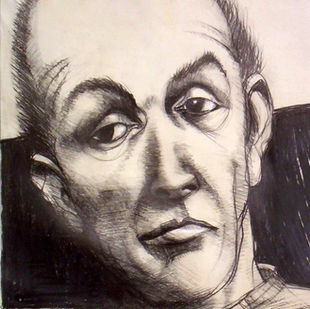
Los Colmilludos, 2006. graphite on paper (this drawing has been lost)
Personal Favorites
"If a painting is like a symphony, drawing is a sonata; precise, economical; in every line a haiku."
- Jonathan Barbieri
The crime

The Judge
Testa Efimera
Bone and other hard tissue, as revealed through the X-rays, provide a template from which the drawings in this series are extrapolated. I am interested in what happens when the poetics of drawing mix with this strictly empirical technology.
In the context of the works produced for this series, the X-ray's narrow materialism - its rationale of objectivity - is subverted and repackaged as a metaphorical substratum underpinning a highly subjective sequence of events.
While an important aspect of drawing is its ability to imply or allude to things without actually endowing them with concrete form, the X-ray's principal function is to “see through” opaque surfaces and to give form to things that normally remain unseen. A powerful synergy occurs when the two are combined. They play off of one another and dissolve into each other.
In the earlier works the skeletal elements, so highly visible on the “naked” print at the beginning of the process, ended up becoming fairly obscured by the subsequent veils of paint and graphite. In the next group of drawings, I plan to print the X-ray images darker and allow them to show through a more minimal, less “drawn”, skin. In some of the pictures, the printed elements will turn out to be the dominate feature of the work.
These are essentially portraits. And, the unconventional way in which Testa Efímera addresses the process of portrait-making is worthy of further consideration.
As I stated earlier, I am working primarily from a set of about forty X-ray studies representing the heads of children I've never met. Since I don't know what most of my subjects looked like, I am forced, when rendering their features, either to invent them or to rely heavily upon the osseous topography exposed in the plates. Most often, it's a combination of both - without, frankly, too much concern for scientific method. Still, in the Testa Efímera drawings, the contour of every feature is a direct consequence of the bony visage insinuating itself from below.
Drawing usually works in just the opposite direction, ie from the outside inward; the premise being that it's possible to circumstantially represent an unseen interior by plotting the events it produces upon the visible surface. The best portraits are rarely concerned with precise representation. Rather, their true subject is the pneuma who, from the deep, disturbs the mantle above. The portrait artist is like a man in a boat, bobbing on the sea. Busily charting the ripples, he hopes for some sign that might reveal the nature of what swims beneath him. As if the soul were some giant fish.
The drawings in Testa Efímera present us with a case of portraiture conceived and executed in a direction exactly contrary to what convention has taught us to expect: the work begins at the “core” of the subject and progresses outward. At some point, however, interior and exterior lose their spatial autonomy. One passes through the other and visa versa. The drawing then begins to unfold in its own special terms: between interior and exterior, matter and ether, body and soul.
But, beyond aesthetics and a re-examination of portrait-making, beyond the comfortable closed circuit to which most contemporary art theory confines itself, there is another imperative driving this project: Warfare, slavery, sexual exploitation, hunger and disease are rampant in the world at the beginning of the 21st century. That the primary victims of these ravages are children deforms the very idea of civilization. Framed by this brutal reality, my decision to incorporate x-ray images of children with head traumas, as a metaphorical foundation for these drawings, was by no means casual.



































